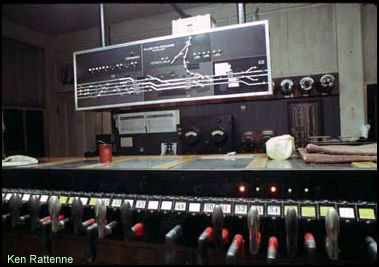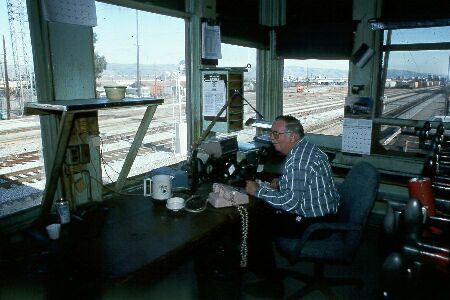

 |
A
Look Inside
The interlocking machine in College Park Tower. Trackage taken out of service is reflected on the track diagram board by paintingover the affected route with black paint. (Ken Rattenne Photo) |
Truly the heart of any tower is itsinterlocking machine.
Both towers in San Jose had mechanisms housed inside largecabinets spanning the length of each tower's second story. These cabinetswere made of solid wood stained a dark, natural color. The top of each cabinet had a glass top exposing the inner workings of the interlockingplant housed within. The glass was hinged to allow signal maintainers accessto any part of the interlocking's electrical devices, a common occurrencein the last days of both towers.
Protruding from within each interlocking cabinet wererows of inverted "L" shaped pistol-grip handles, molded to fita hand. These grips literally ran the length of the interlocking cabinet,one for each switch and each signal operated within the towers' limits.The stem of each lever was coded by a band of color: Black for switches,red for signals. Above each cabinet was a metal box. On its surface eachtrack and turnout was represented in a route diagram. A panel light wasset next to each representation of a switch, illuminating when a trainpassed over its track sensor. Each light was numbered to correspond tothe correct controlling lever on the interlocking cabinet. This arrangementresulted in two rows of levers, one above the other, for each switch andits signal.
What is an "interlocking"
plant? Let's go backto Santa Clara Tower. A CalTrain approaches from San
Francisco, slowingfor the Santa Clara stop. After pausing long enough to
detrain passengers,weekend Train 149 highballs for San Jose, its leading
F40 laying down alight trail of exhaust.
Operator Don Douglas finishes his entry on the Train MovementSheet, then speaks into the radio.
"Santa Clara OS!"
 He
waits briefly, staring at the radio's brushed aluminumfront panel. He begins
tapping his pencil...
He
waits briefly, staring at the radio's brushed aluminumfront panel. He begins
tapping his pencil...
"Transmit" comes a metallicreply over the radio.
"Santa Clara OS... 149 at 10:06, one double-naughtsix am."
The SCO acknowledges as Don glances up at the track boardwhere a flashing light is visible on the panel just below the diagram case.When asked about the light, he sheepishly replies, "Oh,I didn't pick up the signal in time when 149 went by, so the switch wentinto time." Went into time? Don explains further.
" That occurs to prevent you from throwing a signaland changing the lineup in the face of a train. What happens is a timerlocks the lineup in place..."
All of a sudden we hear
a loud clank.
"It just released."Don grabs the switch lever and pushes, shoving it in withanother loud "clank" which clears the flashing light.
Don is yanking on the lever but it doesn't move. Point taken. You might say that no switch could be thrown before its time.
"When it releases, it clicks, then I can push thelever in all the way in and make a change in the lineup. However, while it was flashing it was locked-up. For instance, if I try to pull on this No. 17 signal ...it won't come out. It's lockedup."
The mechanism that had just cleared was timed for a full10 minutes, as were all switches connected to the mainline. Yard switchescould be as little as 45 seconds. Veteran operators will say it was thepossibility of tying up the mainline or an important yard lead with anincorrect line-up that gave a towerman ulcers.
This document is Copyright©1998-2011
by Ken Rattenne and KPR Media Services
and was last updated in November of 2010